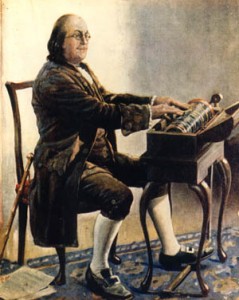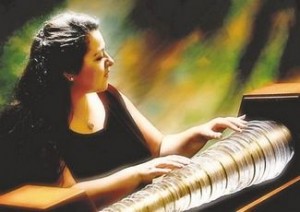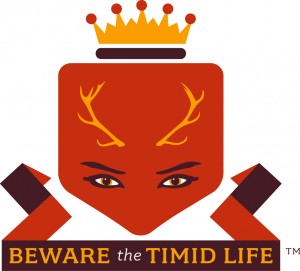Ben Franklin’s Glass (H)armonica: An Instrument of Desire
 Now nearly forgotten, the glass harmonica is a real instrument that once swept Europe and America. While the protagonist of The Glass Harmonica, Chjara Vallé, is fictional, the musical history featured in the novel is accurate. Author Dorothee Kocks, PhD, American Studies, Brown University, devoted eight years to researching and writing the book. For details, see Truth in Fiction.
Now nearly forgotten, the glass harmonica is a real instrument that once swept Europe and America. While the protagonist of The Glass Harmonica, Chjara Vallé, is fictional, the musical history featured in the novel is accurate. Author Dorothee Kocks, PhD, American Studies, Brown University, devoted eight years to researching and writing the book. For details, see Truth in Fiction.
1. The glass harmonica qualifies as America’s first “pop” phenomenon as it was wildly popular, caused girls to swoon at its eerie sounds, then faded as quickly as it appeared. Like Chjara Vallé in the novel The Glass Harmonica, some of the most famous players were women.
2. Benjamin Franklin invented the instrument based on the finger-around-the-wineglass idea. Glassmakers created some 5,000 instruments during its heyday, from the 1760s to the 1820s. Mozart and Beethoven composed for it, Franklin played Scottish ballads on it, and Franz Mesmer mesmerized his patients with it. A memorable scene from the novel features a fictional student of Mesmer’s recreating the master’s erotically charged séances.
3. Set in a case like a harpsichord, Franklin nested 37 glass bowls inside each other on an iron rod, from large bass bowls to tiny high-pitched cups. Bits of cork separated the bowls so they wouldn’t rub against each other. A foot treadle spun the axle-rod. Players dipped their fingers in water before touching the spinning glass bowls to produce the ethereal notes.
4. The type of water – hard, soft, cold, hot – is important, as Chjara discovers when her first touch produces a squawk. Today, glass harmonica players favor Arrowhead spring water.
5. People waxed poetic about the sound, calling it “celestial ravishment,” “godly Bliss,” “electrical music,” with “even ladies of more mature age” believing they experienced “pangs of blessed rapture.” Chjara describes the erotic tingling after playing as “all my body is in a fever.”
 6. Like Tibetan singing bowls and church bells, the glass harmonica follows a circular wave guide, the sound going around and around the rim of the bowls. The piano, string instruments, woodwind and brass instruments all create a linear wave guide. Circular wave patterns are reputed to have healing powers.
6. Like Tibetan singing bowls and church bells, the glass harmonica follows a circular wave guide, the sound going around and around the rim of the bowls. The piano, string instruments, woodwind and brass instruments all create a linear wave guide. Circular wave patterns are reputed to have healing powers.
7. Controversy stalked the instrument. After a child died during a performance, rumors spread of the instrument’s extreme effects on the nerves. Several German towns banned it “on account of injury to one’s health and for the sake of public order.” Some players were hospitalized for hysteria. The instrument was blamed for a wide range of maladies, including premature birth and convulsions in cat and dogs. Then as now, controversy only increased the public’s fascination with the instrument.
8. Thomas Jefferson wanted to purchase an expanded instrument, six octaves long instead of three, but glassmakers quailed at the challenge.
9. Franklin named the instrument “armonica” after the Italian armonia, meaning harmony. The present-day maker of the instrument spells the word with an h – harmonica. The familiar blues harmonica, also known as a mouth organ or harp, was invented many years later.
10. Gerhard Finkenbeiner, a Massachusetts-based scientific glassblower, reproduced the instrument in the 1980s. He later disappeared in a mysterious plane crash. His body and the wreckage were never found. The company survives; a new instrument costs upwards of $35,000.









